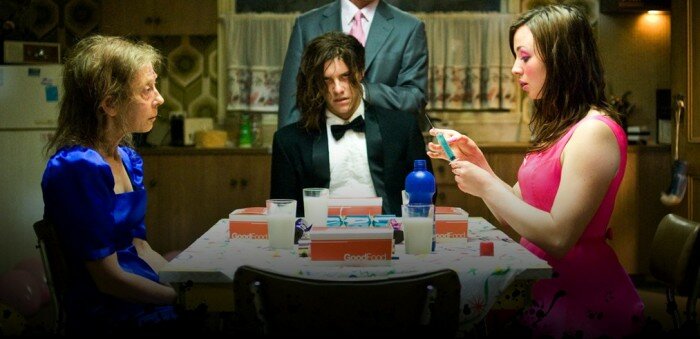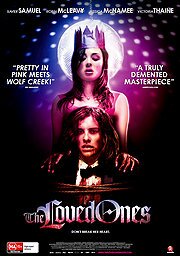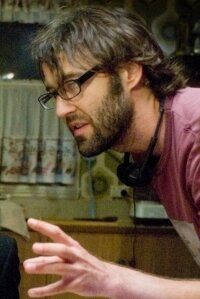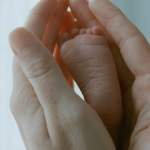Writer/director Sean Bryne’s feature-debut The Loved Ones is the latest homebrew horror to hit Australian cinemas, a genre that our film industry nails — both figuratively and literally — time and time again. In this gleefully gory outing, the polished nails belong to teen “princess” Lola (Robin McLeavy), a fantastically insane serial killer who tortures her prom date Brent (Xavier Samuels) with playful malice. You can read our four-star review of The Loved Ones here, but in short, go and see it…so long as you’ve got the stomach for it.
While promoting The Loved Ones in Adelaide, I sat down with both Sean and Robin to talk about their movie. While it’s a little intimidating being in the presence of someone you have witnessed using a power tool in a variety of unholy ways, both Robin and Sean turned out to be very personable, down-to-earth people who really embody the laidback charms of our film industry. During our twenty minute chat, we discussed the great retro mood of The Loved Ones, the extensive research that goes into creating an iconic horror villain and the process of taking what’s on the page and brining it alive on screen.
Read on for the full transcribe!
Cut Print Review: The Loved Ones has been on the festival circuit for a while now, but I believe this is actually the film’s first theatrical release, correct?
Sean Byrne: Yeah, it’s really exciting. It’s D-day! [laughs]
The film has become a real festival darling and we won the Midnight Madness Award at Toronto [International Film Festival] against Hollywood fare, so it can’t have done any better in terms of building up brownie points on the festival circuit. But the jury’s still out in terms of general audiences.
CPR: Any particular reason for the delay in making it to Australian cinemas?
Sean: Oh there are a lot of factors, such as trying to get the right release date. But I think it always helps in Australia if a film has international recognition first. The Australian audiences have a kind of history of preferring a film if it already has some credibility.
Robin McLeavy: Especially with horror. It makes a big difference.
CPR: Do Americans consider Australians experts in horror? I mean, nowadays, the only major films they tend to see from our industry are the likes of Saw, Daybreakers, Wolf Creek and now The Loved Ones…
Sean: Well, Saw and Daybreakers were Lionsgate releases, so they almost see those films as their own even though they were made in Australia mostly by Australians. I think Wolf Creek was a real standout because it shows what a purely Australian horror film can do on the international market. So that’s still kind of the template.
But really, I think America still remembers Crocodile Dundee! [Laughs]
CPR: What’s great about your film is that it feels “old school”. While every other horror is trying to be modern with found-footage style or in 3D, your film takes horror back to the 80s style of blood, guts and disco balls. I assume that was very calculated?
Sean: Yeah, we took making the film very seriously, but I didn’t want it to be a super-serious film. A fun, freaky, gleefully-demented roller-coaster ride. I liken it to Sam Raimi’s Evil Dead 2, which is such a fantastic, wild cinematic experience. So that was a major reference. I always wanted audiences to be screaming their lungs out and laughing their ass off at the same time. If that is possible!
|
|
CPR: You’ve definitely achieved that. It’s one of those films where you can’t work out whether to laugh, cry or just anxiously peer through the gaps of your fingers. It’s a lot of fun to watch.
Sean: Yeah, that’s it. That’s the word that seems to pop up a lot: fun. And it is. It’s meant to be a fun ride.
CPR: How do you feel about the genre label “torture porn” and do you think it applies here?
Sean: No, I don’t think it applies to The Loved Ones because it’s too much of a party to be torture porn. Torture porn is usually nihilistic and bleak and I think The Loved Ones is actually quite cathartic in a way. I think it’s actually quite a positive film!
Robin: We’re calling it glam horror. Or disco horror!
Sean: Yeah. I mean, I like a lot of the films that get labelled torture porn, but it’s sort of got negative connotations now. Whereas this is really a pop horror roller-coaster.
CPR: Robin, easily one of the most entertaining qualities of the film is your crazy character Lola, who has already garnered a bit of a cult following online. Before we talk more about your character, I’m dying to know if anyone dressed up as Lola, aka “The Princess”, for Halloween?
Robin: Well, I’ve got a big Halloween party coming up this weekend. A late Halloween party. But yeah, one of my friends worked on Inglourious Basterds and so last year they made a prosthetic piece for my friend and she came as a Nazi with a bit of brain hanging out. So hopefully, if no one is dressed as Lola, I’m thinking maybe I will go as her! I’ve still got the dress!
CPR: That would be great! People will do a double-take….and then run for their lives.
Robin: [laughs] yeah!
Sean: There’s been a couple of American reviewers who said they were going to dress up like Lola for Halloween.
Robin: Yeah, that’s right. I wonder how that went.
As for the whole cult thing…it’s just amazing. All these horror websites have been going nuts over it. And it’s great to have that kind of recognition before the release.
Sean: Online, the film has been called a cult classic before it has even come out, which is just fantastic.
CPR: Robin, have you sat in a cinema with a full audience to gauge their reaction towards your character?
Robin: Yeah, I went to Texas for the SXSW Film Festival and the audiences were so vocal and so into it. They were screaming, laughing, cheering and clapping. And jeering, wanting me to die… [laughs]
CPR: It must be strange being surrounded by people wanting you, or your character, to die!
Robin: It’s surprising at first, as I’m like “Oh no! They all hate me!” But then you realise it is, actually, a compliment. Because it means that they are invested in the film enough to want Lola to, well, cop it!
Sean: Yeah, audiences love to hate the monster, so the more vocal they are, the biggest the endorsement for the monster.
CPR: Do your friends and family see you in a different light having seen the film?
Robin: Yeah, some of them are a bit scared of me now, but honestly, a lot of them were like “yeah, I always knew you were capable of that!” [laughs]
CPR: Lola is probably one of the most fantastically insane characters I’ve seen of late, so I’ve got a challenge for you Robin: I want you to try and rationalise her psyche. Make me believe she’s really kind of normal.
Robin: Oh wow, normal? I’ve always wanted the opportunity to defend her, so here it goes…
Lola’s really just a lonely, lost little soul. She’s socially inept and doesn’t know how to communicate with kids at school, or anyone other than her father. She’s also looking for love! And she’s very sensitive, so when she gets turned down…she takes it really personally.
Sean: Hopefully people will be able to relate to an extent, because everyone’s had their heart broken before. Because in many ways it is just about a girl who has a crush on a guy, it’s just in the magnitude of her reaction that sets Lola apart from the average girl.
CPR: The film also looks at the closeness and trust that exists within a small country town, and naturally being a horror movie, exploits both. Sean, did you grow up in a small country town?
Sean: We both actually grew up in Tasmania…
CPR: Oh right, so of course you did! [laughs]
Sean: [laughs] Yeah. So the film was actually originally set in Tasmania – Kempton, I think. But for various reasons, such as being easier and more financially feasible, we ended up shooting it in Victoria.
But it was a low-budget film so I just thought it lent itself to the trust and security of a small town community. Also, the cast doesn’t have to be that big. So that was really the main reason.
CPR: Was there anyone in your neighbourhood who you thought was a bit strange and creepy? You know; suspect serial killers operating behind closed doors.
Robin: Oh I did. I won’t mention any names, but there was this guy who cut the heads off some kittens and put them in a mailbox…
Sean: [shocked] wow…
Robin: yeah… [laughs]
Sean: Well I was in a nice, warm cotton-wool neighbourhood. There was none of that.
CPR: Did you do a lot of research on the psyche of serial killers?
Sean: Yeah, I did a lot of research. I especially looked at the serial-killer Ed Gein, who was also the inspiration for Psycho, Texas Chainsaw Massacre and Silence of the Lambs. And also Jeffrey Dahmer, the notorious serial killer who used to lobotomise his victims, which we kind of borrowed from but I won’t go into too much detail about that.
CPR: What was something you learnt that surprised you or stuck with you?
Sean: I think the biggest surprise from my research was just how seemingly normal and almost invisible sociopaths actually are. These are people that exist on the periphery of society and have basically slipped through the cracks. That’s how they do what they do for twenty, thirty years. Usually they’re kind of devoid of charisma and empathy, so the reason that they do what they do is because they have to go to extremes to feel anything. I read somewhere that to a serial killer, tears are like candy. To them, it’s like watching a really exciting film; you’re so close to the drama that you can actually feel something. It excites them. So it’s a sickness that probably goes back to their socialisation, or whatever. But I just needed to understand it in a general sense so that the characters weren’t one dimensional before handing it over to the amazing actors!
CPR: So Robin, how did you go about getting inside Lola’s headspace?
Robin: Well Sean gave me a hundred pages of research that he’d done on Jeffery Dahmer and some visual references to films and characters that he wanted to get a similar feel from. Because I’m a bit of a wimp, I read the Jefferey Dahmer stuff and got really freaked out. Then I read a book called The Man Who Mistook His Wife for a Hat by Oliver Sacks, a neuropsychologist who has this amazing ability to write in depth about his patients but not to judge them. He describes one of his patients episodes in the words of the patient, saying that they feel maniacally well when they’re on the verge of going into an episodic moment. He also talks about this musical illusion that they start to imagine in that they believe they can actually see music. So I was on set listening to Britney Spears at the dinner table with the chicken. [laughs] My rationale was that if I start from a place that was kind of sensoric and exciting it was just going to add to the scene — give another dimension or another feeling to the vengefulness and the violence.
CPR: Lola has all these great mannerisms and quirks that really bring out her sense of crazy. Were these all your little touches or were they in Sean’s screenplay from the get-go?
Sean: Well once the script has been written, you go through the horrid casting process. When Robin came in, I breathed a huge sigh of relief; she really just filled Princess’ shoes. While I had my own idea of what each moment should be and of the overall jigsaw puzzle, I tried not to get in the way. Robin would always come up with little moments, such the aeroplane moment [where Lola simulates an aeroplane with the fork when forcing Brent, her hostage, to eat]. And it was like that for most takes — constantly better than I could have ever imagined.
Robin: It’s funny because the words are on the page and it just seemed natural to respond in that way. It was this seamless marriage between Sean’s vision and my vision.
Sean [to Robin]: Well you’d done so much detailed character work that it was so exciting for me to watch your character come to life.
Robin: Sean was actually scared of me on set, which was quite funny. I’d sneak up on him and whisper, “you’ve created me!” [Laughs]
I remember at the time I was listening to one of those Radiohead songs which was just strange noises.
[Robin simulates peculiar, otherworldly noises]
CPR: Oh that’s got to be “Like Spinning Plates” off of Amnesiac…
Robin: Yeah, yeah!
Sean: I think that’s what great actors do with horror roles; they transcend them. It becomes just a really nuanced performance, and because it’s so nuanced, it becomes more real and people start to really embrace the monster. It’s like that with Anthony Hopkins in Silence of the Lambs and Kathy Bates in Misery. You know what I mean? They’re just really great performances, and in turn, that brings us closer to the horror.
CPR: Yeah, definitely. There are also distinct elements in their performances and personas that really trademark them, which I think is what gives birth to the whole “iconic” status. I mean, Lola is forever going to be remembered for her bloodied pink dress, party crown and that damn Kasey Chambers song “Not Pretty Enough”. Which, by the way, is Just. So. Creepy.
Robin: [laughs] Yeah that song is really the perfect fit for her because the lyrics are about wanting to be validated by a boy. So it was creepily perfect.
Sean: It was actually my second choice because I was worried it was so accurate that it was going to be a bit on the nose. But luckily, it wasn’t. Originally, it was going to be Kasey Chambers’ cover of Cyndi Lauper’s “True Colours”, because I thought that tied in nicely too.
Robin: I loved that song as a kid, so I’m glad you didn’t use it!
Sean: Both worked nicely against the violence. I was really influenced by [Quentin] Tarantino with his use of “Stuck in the Middle” in Reservoir Dogs. Such a great scene!
CPR: What’s something you’ve learnt from this experience you wish you had known beforehand?
Robin: While I had a lot of fun, I did have days where I questioned if I was doing too much, or not enough. Like sometimes I just didn’t have a gauge of where to go. So my advice would be to just trust your instinct, and trust all the work is there.
Sean: My advice would just be to do as much preparation as possible, because you don’t get a long shoot in Australia. Also, try and get the little details right. Because they accumulate and that’s what makes the overall experience great.
The other thing that I’ve learnt is to never shoot six-day weeks. Because when it hits the Saturday, people just automatically go into Saturday mode. You’re also just too exhausted to function. So don’t underestimate the benefits of five day weeks!
CPR: Last question, if you couldn’t have a career in film, what would you be doing?
Robin: I would probably like to be a chef…
CPR: …having seen you wield a knife, that’s a scary thought.
Robin: [laughs] Or a massage therapist? Hmm, that’s also a bit scary…
Sean: Well I always wanted to bat first drop for Australia…. [laughs]
So I think there was always more chance of me becoming a filmmaker.
—
The Loved Ones is in cinemas across Australia now.
 Follow the author Anders Wotzke on Twitter.
Follow the author Anders Wotzke on Twitter.



![lovedones[1] lovedones1 Interview: Sean Byrne and Robin McLeavy of THE LOVED ONES](/wp-content/uploads/lovedones1.jpg)






![The Troll Hunter [Trolljegeren] (Video Review)](/wp-content/uploads/1102_the-troll-hunter-150x150.jpg)

